Teaching the world's most common suffix
The suffix ‘s’ joins suffix ‘ing’, ‘ed’ and its partner in crime suffix ‘es’ to make up a whopping 65% of all suffixed words. So let’s have a look at how to teach this suffix well, including some background grammatical knowledge that can also be taught while teaching this suffix.
Why two posts on the same suffix?
You may notice that we have two posts on teaching the suffix ‘s’. The other one is here Sample lesson suffix – s.
This is because there is no single correct way to teach any of these concepts. In fact, it’s important that we develop some flexibility in our approaches. This lesson from Bill assumes that the kids are familiar with and can read the words ‘dog’ and ‘bark’. If they have not yet reached this point in their program sequence, choose other words that they can read.
If you are following the Playberry (or other) intervention structure, be aware that the word ‘bark’ would be out of sequence here.
The online Word Cracker presets are all designed to fit in with the Playberry sequence, but nothing stops you from choosing your own base words for your students based on their interests and reading skill level, as Bill has done here.
The suffix 's' is deceivingly complex
The typically developing speaker and reader intuitively cottons on to how suffix ‘s’ is added to bases to make a noun plural (more than one) and how it can help a verb to work in a clause or a sentence. You’ve probably noticed that there’s a lot of metalanguage here. Noun, plural, verb, clause and base become important words that students need to become familiar with. So let’s go through step-by-step how to teach suffix ‘s’ and the accompanying metalanguage. This teaching process can be used with a whole class or in an intervention setting.
Adding suffix 's' to make nouns plural
1. Type the noun dog into the middle section of the cracker (where bases go). Make sure to remind the student(s) that bases go here! If students are working from personal Word Cracker Whiteboards, instruct them to write dog into their crackers and chin it so you can check they’ve spelled it (or any other base you’ve asked them to write) correctly.
2. What follows is based on Bill’s dog situation but you get the idea about building some context around teaching suffix ‘s’!
“I have a dog at home; his name is Arlo. Arlo is a nice dog (point to dog in the Word Cracker), but boy, can he be naughty sometimes when he sees people outside. Arlo loves to bark at people when they walk past the house!”
The word dog is a name for a type of animal. Words that name things are called nouns. The word dog is a noun, and nouns are words that name things.”
Now I’m a sucker for the power of having students repeat back important information I’ve just taught them, so I often ask students to repeat back, part by part, important information.
3. Then say:
“Oh, I should mention, Arlo isn’t my only dog (point to dog in the Word Cracker). I also have Ashleigh. She’s the one who taught Arlo to bark at people outside. So I don’t have one dog at home (pointing at the Word Cracker); I have two dogs!”
“Oh, oh, The Cracker doesn’t say dogs. It says the base dog. This base needs a suffix to tell us that I have more than one dog. What suffix do I need to show that I have dogs at home?

The student(s) will quickly identify that we need the suffix ‘-s’. Bring it down into the suffix part of the cracker and say:
“I have two dogs at home who both bark! The suffix ‘s’ has an important job. What does it tell us about the number of dogs I have at home?
That’s right. It tells us that I have more than one dog. It makes the base dog into a plural. Repeat after me – one at a time:”
If students are working from personal Word Cracker Whiteboards, instruct them to write the suffix ‘s’ into the suffix section of their cracker and chin it to you can check and correct.
4. Now it’s time to use a choral response routine to embed what was just taught. This is a my turn your turn routine where the teacher says “my turn” then says a dot point, then says “your turn”, and the students repeat what the teacher just said.
- By adding the suffix ‘s’ to the noun dog …
- We made the plural of dog – dogs …
- Plural means more than one …
- Suffix ‘s’ made the noun dog plural …
- The plural of dog is dogs.
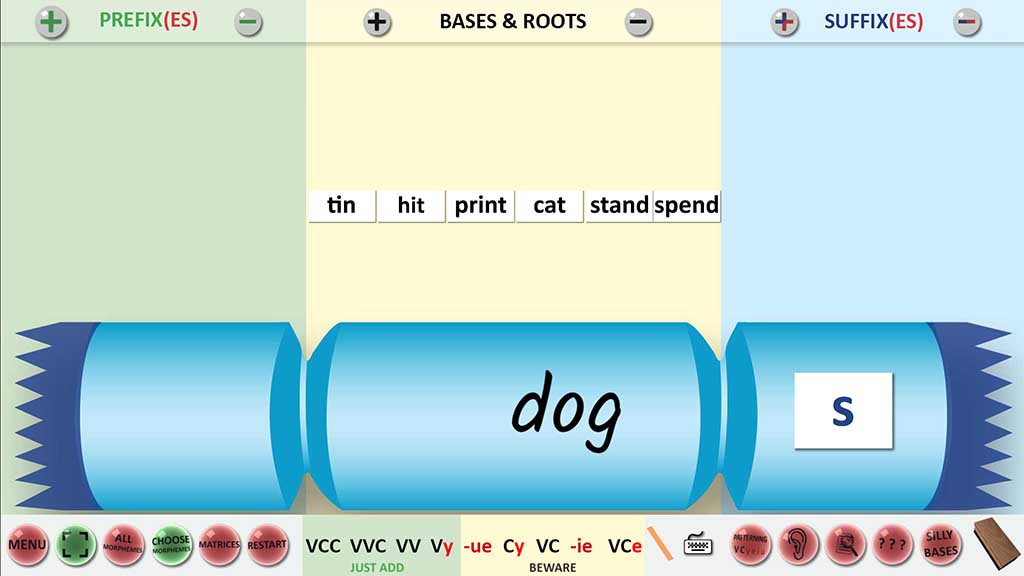
5. Now it’s time for a little rehearsal. Use the type function to type some simple singular nouns (you can type up to six) into the Word Cracker and play with bringing suffix ‘s’ in and out, saying the singular and the plural forms:
“The plural of cat is cats…. The plural of car is cars … the plural of computer is computers … and so on.
You can also use the pre-set tiles (only the nouns) that are already there.
As you do this, you might want to quickly drag the nouns and the suffix ‘s’ in and out of the cracker, but if you’re as clumsy as I am, don’t bother! Kids usually have the idea by now. You might get them to write some of these different nouns into their own crackers and practice adding the suffix ‘s’. This will involve some quick-fire writing and erasing on their Whiteboard Crackers.
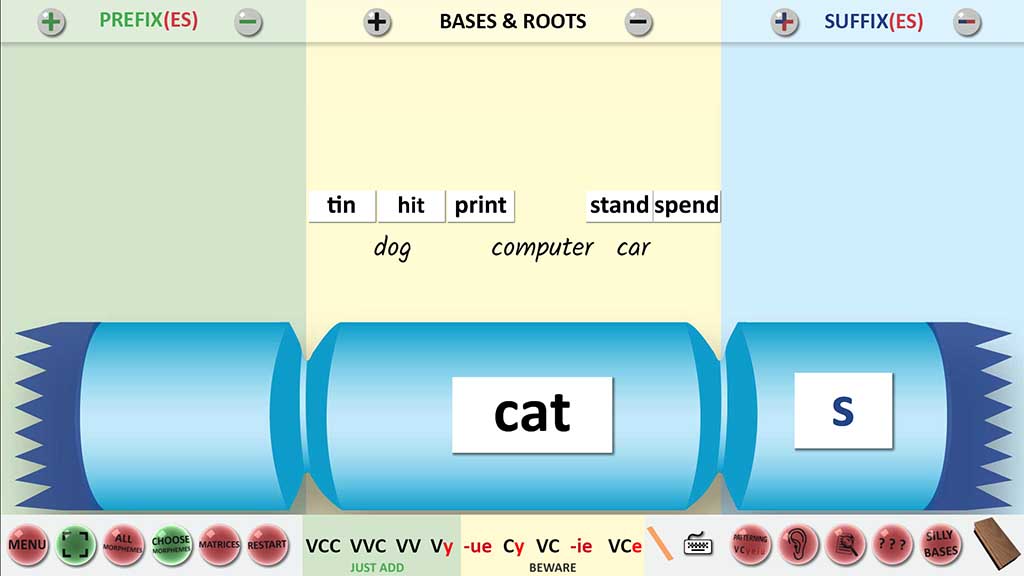
Adding suffix 's' to help a verb to work in a clause
Teaching the second function of the suffix ‘s’ might be best saved for another lesson if the previous knowledge is all new for your student(s).
1. Type the verb bark into the middle section of the cracker where bases go. If students are working from personal Word Cracker Whiteboards, instruct them to write bark into their Word Crackers and chin it. If students haven’t been taught the code for bark, then you’ll need to use a word with grapheme-phoneme correspondences that students already know.
Say:
“Now I was telling you about how my dogs Arlo and Ashleigh are a little bit naughty and love to bark at people when they walk past the front of my house.”
When people pass our house, Ashley will always bark first and then Arlo bark next,
When I say the second bark, I phrase this sentence very deliberately to illustrate that the second bark is not grammatically correct when said like this. I like to look confused and then repeat it…
“Ashley will always bark first, and then Arlo bark … next! … Hmmm, that doesn’t sound at all right. I’ll try it again!”
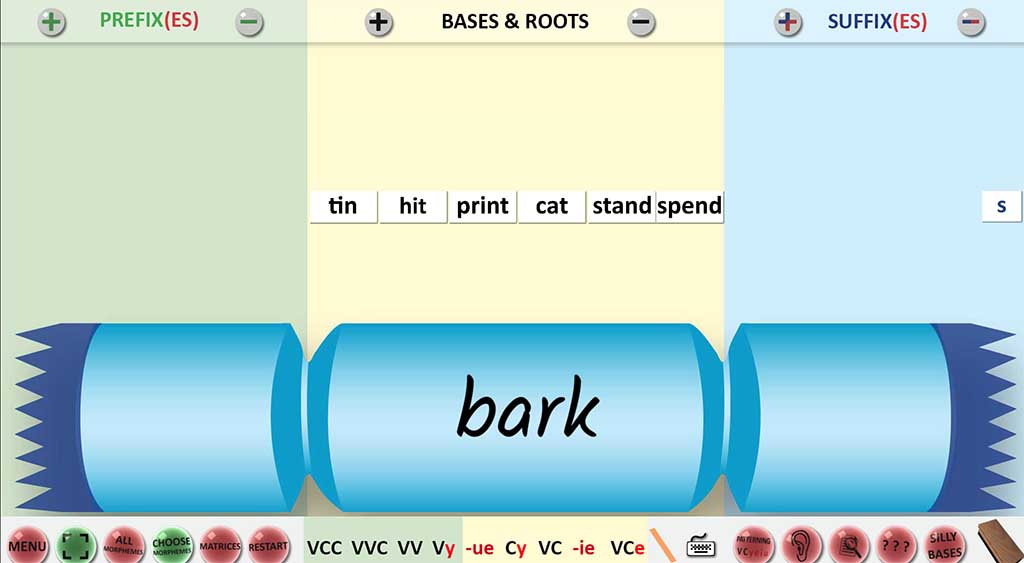
By now the student(s) are jumping out of their skin to correct me with barks.
“Oh! I need to use the suffix ‘s’ to make the verb – bark sound right in this sentence!
Ashley will always bark first and then Arlo barks … next!
Gosh, that sounds much better. That second verb needed suffix ‘s’ to make sense in this sentence.
2. So now we recap with the students!
The suffix ‘s’ is a very important suffix because we add it to lots of nouns to make them plural and we add it to verbs to make them sound right in a clause or a sentence.
3. Now we can use a choral response routine again to embed what was just taught. This is a my turn your turn routine where the teacher says “my turn” then says a dot point, then says “your turn” and the students repeat what the teacher just said.
- By adding the suffix ‘s’ to a noun we make a noun plural
- A noun is a word for a person, place or thing
- Plural means more than one
- By adding the suffix ‘s’ to a verb we make it work in a sentence
- A verb is an action, being and having word
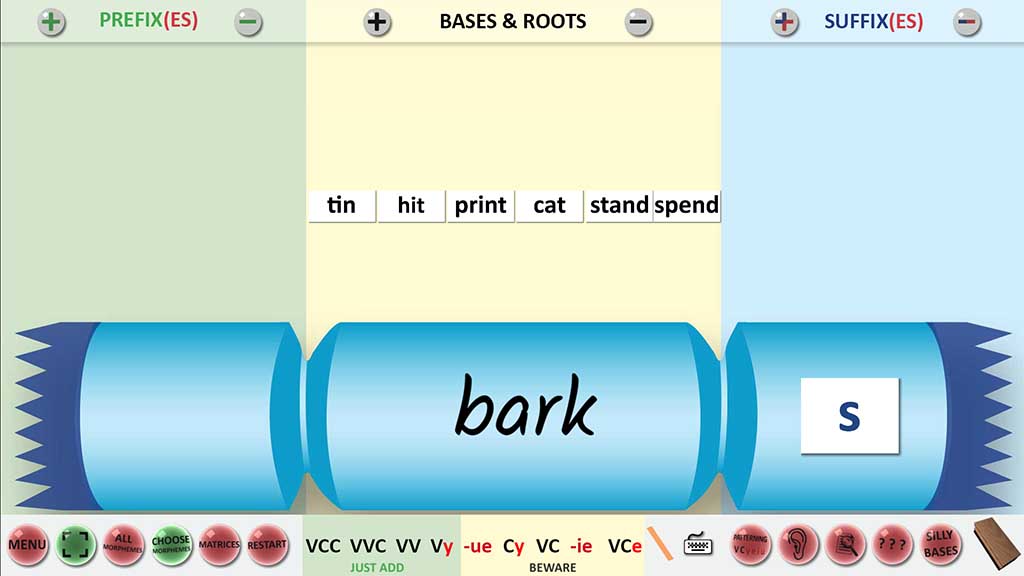
Conclusion
So, that’s the way I introduce the suffix ‘s’ to students using the Word Cracker. Regardless of whether it’s in an intervention setting or in front of a class these same process could be followed. It’s important that students are engaged in choral responses and/or pair shares with other students as well as following you and writing the bases with suffix ‘s’ in their own Word Cracker whiteboards, or in books. As student responses go up, engagement and retention of new knowledge goes up. Bear in mind that this same instruction will need to be repeated many times over as part of a review cycle and the definitions (noun, verb, suffix, base, plural) will need many, many more repetitions to stick in students’ long term memories. Playberry tier 1-2 and Playberry tier 3 has review routines built-in to embed the terms taught in this lesson. Word Cracking is the official morphology arm of Playberry.


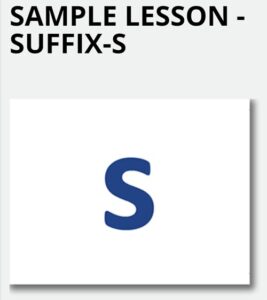
2 Responses
Good video
Easy to follow
Great to model
Thanks for the feedback, Bev! Glad you like it.